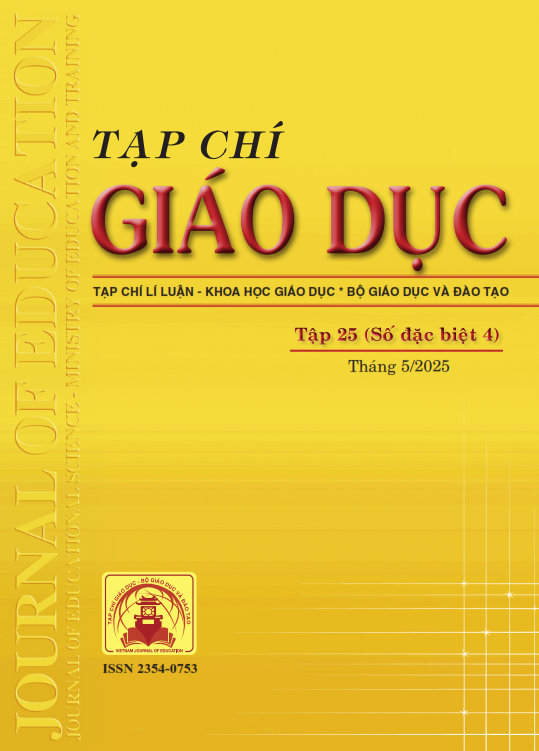Tần suất sử dụng từ phái sinh trong bài viết tranh luận của sinh viên chuyên ngữ tiếng Anh và mối liên hệ với vốn từ vựng
Tóm tắt
Derived words play a crucial role in the development of English vocabulary and skills for English as a foreign language (EFL) students. However, few studies have investigated the use of derived words in the writing of language learners in relation with their vocabulary size, especially in the Vietnamese tertiary context. This article thus explores the frequency of use of derived words in argumentative essays by Vietnamese English-majored university students according to Bauer and Nation’s (1993) framework. The collected data comprised 73 argumentative essays written by 73 second-year English majors at a university in Vietnam and their vocabulary breadth test scores. The results revealed that derived words in students’ essays accounted for about 10% of the total words. In addition, the more English vocabulary students had, the more they tended to use derivatives in their essays. In light of these findings, the paper discusses important pedagogical implications for developing students’ vocabulary and enhance their use of derived words in EFL writing.
Tài liệu tham khảo
Bauer, L., & Nation, P. (1993). Word families. International Journal of Lexicography, 6(4), 253-279. https://doi.org/10.1093/ijl/6.4.253
Chan, A. Y. (2010). Toward a taxonomy of written errors: Investigation into the written errors of Hong Kong Cantonese ESL learners. TESOL Quarterly, 44(2), 295-319. https://doi.org/10.5054/tq.2010.219941
Cobb, T. (2025). Morpholex Affix Profiler. Accessed 11March 2025 at https://www.lextutor.ca/cgi-bin/morpho/lex/.
Crossley, S. A. (2020). Linguistic features in writing quality and development: An overview. Journal of Writing Research, 11(3), 415-443. https://doi.org/10.17239/jowr-2020.11.03.01
Gebril, A., & Plakans, L. (2016). Source-based tasks in academic writing assessment: Lexical diversity, textual borrowing and proficiency. Journal of English for Academic Purposes, 24, 78-88. https://doi.org/10.1016/j.jeap.2016.10.001
González, M. C. (2017) The contribution of lexical diversity to college-level writing. TESOL Journal, 8(4), 899-919. https://doi.org/10.1002/tesj.342
Ishii, T., & Schmitt, N. (2009). Developing an integrated diagnostic test of vocabulary size and depth. RELC Journal, 40(1), 5-22. https://doi.org/10.1177/0033688208101452
Iwaizumi, E., & Webb, S. (2022). Measuring L1 and L2 productive derivational knowledge: How many derivatives can L1 and L2 learners with differing vocabulary levels produce? TESOL Quarterly, 56(1), 100-129. https://doi.org/10.1002/tesq.3035
Iwaizumi, E., & Webb, S. (2023). To what extent do learner- and word-related variables affect production of derivatives? Language Learning, 73(1), 301-336. https://doi.org/10.1111/lang.12524
Kieffer, M. J., & Lesaux, N. K. (2012). Direct and indirect roles of morphological awareness in the English reading comprehension of native English, Spanish, Filipino, and Vietnamese speakers. Language Learning, 62(4), 1170-1204.
Kyle, K., & Crossley, S. A. (2015). Automatically assessing lexical sophistication: Indices, tools, findings, and application. Tesol Quarterly, 49(4), 757-786. https://doi.org/10.1002/tesq.194
Laufer, B., & Cobb, T. (2020). How much knowledge of derived words is needed for reading?. Applied Linguistics, 41(6), 971-998. https://doi.org/10.1093/applin/amz051
Lee, J. (2020). An error analysis of L2 writing: How does task complexity affect L2 errors? The Journal of Asia TEFL, 17(3), 954-965. http://dx.doi.org/10.18823/asiatefl.2020.17.3.13.954
Li, X. (2015). Analysis on lexical errors in writings of Mongolian English majors. Theory and Practice in Language Studies, 5(12), 2565-2570. http://dx.doi.org/10.17507/tpls.0512.18
Llach, M. P. A. (2011). Lexical errors and accuracy in foreign language writing. Multilingual Matters.
Nation, I. S. P. (1990). Teaching and learning vocabulary. Heinle & Heinle Publishers.
Nation, I. S. P. (2013). Learning vocabulary in another language (2nd ed.). Cambridge University Press. https://doi.org/10.1017/CBO9781139858656
Nguyễn Thị Minh Huyền (2021). The effects of morphological instruction on morphological awareness and vocabulary knowledge of grade-10 Vietnamese students. British Council, https://www.teachingenglish.org.uk/ sites/teacheng/files/The%20Effects%20of%20Morphological%20Instruction%20on%20Morphological% 20Awareness.pdf
Phuket, P. R. N., & Othman, N. B. (2015). Understanding EFL students' errors in writing. Journal of Education and Practice, 6(32), 99-106.
Schmitt, N., Schmitt, D., & Clapham, C. (2001). Developing and exploring the behaviour of two new versions of the Vocabulary Levels Test. Language Testing, 18(1), 55-88. https://doi.org/10.1177/026553220101800103
Sukying, A. (2018). Investigating receptive and productive affix knowledge in EFL learners. In D. Hirsh (Ed.), Explorations in second language vocabulary research (pp. 183-218). Peter Lang. https://www.peterlang.com/ document/1055495
Sumalee, P., & Sukying, A. (2024). The effects of derivational suffix instruction on English vocabulary knowledge in Thai high School learners. REFLections, 31(2), 335-352.
Webb, S. & Rodgers, M.P.H. (2009). The lexical coverage of movies. Applied Linguistics, 30(3), 407-427. https://doi.org/10.1093/applin/amp010
Webb, S., Newton, J., & Chang, A. C-S. (2013). Incidental learning of collocation. Language Learning, 63(1), 91-120.
Webb, S., Sasao, Y., & Ballance, O. (2017). The updated vocabulary levels test: Developing and validating two new forms of the VLT. ITL - International Journal of Applied Linguistics, 168(1), 33-69. https://doi.org/10.1075/ itl.168.1.02web
Wood, C., Garcia-Salas, M., & Schatschneider, C. (2023). Examination of an automated Ppocedure for calculating morphological complexity. American Journal of Speech-Language Pathology, 32(5), 2322-2330. https://doi.org/ 10.1044/2023_AJSLP-23-00044
Yıldız, M. (2022). The Role of affixation on lexical richness of EFL learners’ written texts. Ondokuz Mayis University Journal of Education Faculty, 41(2), 617-638.
Đã Xuất bản
Cách trích dẫn
Số
Chuyên mục
Giấy phép

Tác phẩm này được cấp phép theo Ghi nhận tác giả của Creative Commons Giấy phép quốc tế 4.0 .












